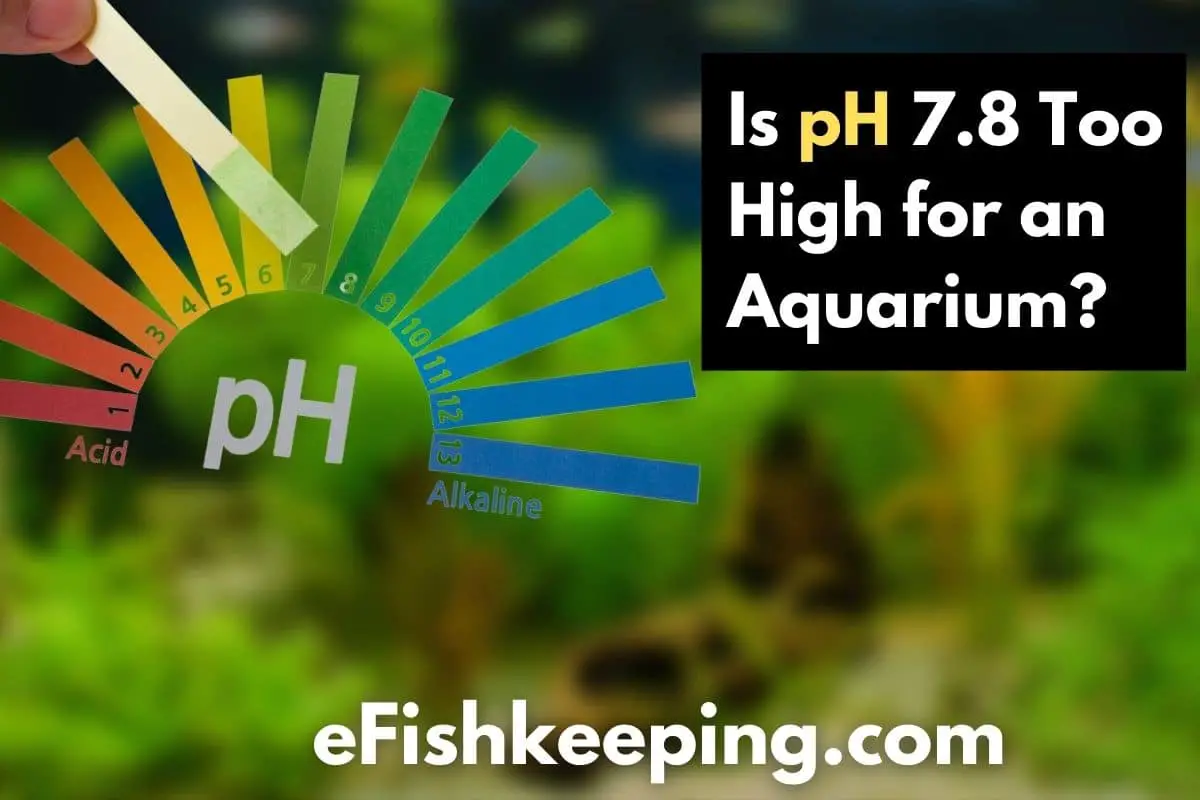The term ‘pH’ refers to the ‘potential of hydrogen’ and it is a measurement of the acidity of a liquid. Aquarium fish live long and healthy lives when the water has a pH level of between 7.2 and 7.8. This means that a pH level of 7.8 is not too high for an aquarium.
A pH level of 7 is neutral, while any number between 0.0 and 6.9 is acidic and a pH value between 7.1 and 14 is alkaline. A pH level of 7.8 is not too high for your aquarium; however, pH levels that are very alkaline or very acidic are dangerous for your fish.
To ensure that your aquarium supports healthy, happy, and thriving fish, you need to keep track of the pH level. This article lists everything you need to know about maintaining proper pH levels including what pH means, how to test your pH, and symptoms of incorrect pH levels.
#1. What does pH mean?
pH is a scale that measures the levels of acidity of alkaline (basicity) of a liquid or aqueous solution.
The more hydrogen ions (often written as the H+ symbol) a liquid has, the more acidic it is and the lower the pH value. Conversely, the fewer hydrogen ions a liquid has, the more alkaline or basic it is, and the higher the pH value.
When a liquid is neutral, it has a pH value of 7. The only liquids that have a pH value of 7 are distilled water and pure water.
#2. What causes an incorrect pH level in an aquarium?
Many factors can contribute to a low pH reading including:
- Having too many fish for the space in the aquarium
- Feeding your fish too much
- Not maintaining a clean tank
- Not replacing water with water that has a correct pH level
- Leaving dead and decaying fish in the tank
- Having too few plants in the tank
There are also factors that can cause high pH reading including:
- Having calcium-rich rocks and stones that can dissolve and release chemicals into the water
- Having aquatic plants that trap carbon dioxide
- Having a poorly-functioning filter
- Using alkaline tap water to refill your tank
#3. What are the symptoms of incorrect pH levels in your aquarium?
There are several important signs that the pH levels in your aquarium are either too low or too high.
Signs your pH levels are too low
- Excessive algae growth because algae thrive in slightly acidic environments
- Dirt build-up or sludge at the bottom of the tank, thanks to uneaten food that cannot decompose because of low oxygen levels
- Stressed fish that are reluctant to eat, are sluggish, and swimming without vigor
- Your fish spend time lying on the bottom of the tank or stay at the surface
- Your fish appear paler in color than normal
Signs your pH levels are too high
- Your fish suffers from alkalosis, which is exhibited as excessive excitement and fast, chaotic swimming patterns
- Your fish try to jump out of the tank
- Your fish scratch themselves on rocks
- Your fish swim with their fins spread wide
- Your fish’s gills secrete mucus
- Your fish will appear sluggish
- White spots appear on your fish
- Your fish may have trouble breathing and they gasp for air near the surface
If you witness any of these symptoms, test your tank’s pH levels.
#4. How often should I check the pH?
It’s a good idea to check your pH levels about once a month if the aquarium is generally in a healthy state.
However, if you have experienced incorrect pH levels in the past, checking every two weeks is a good idea. And always check the pH levels if your fish appear unwell or there has been a fish death in the tank.
pH levels can change depending on the temperature and time of day, so try to check the levels at the same time of day.
#5. How do I test my pH levels?
There are several ways to measure your pH levels.
pH meters
These are the most accurate way to measure pH in aquariums, but they are generally only used by professional aquariums. They are comprised of a pH probe that is attached to a meter.
Because pH levels naturally fluctuate throughout the day, these must be used at the same time each day, and the probe thoroughly cleaned between each reading.
pH paper test strips
Although not as accurate as pH meters, these Litmus paper strips are generally considered to be accurate tools to measure your aquarium’s pH levels by comparing the test strip to a color chart provided.
#6. Should I change pH levels?
Fish can become sick if pH levels change quickly. So, if your fish are not showing signs of distress, and your pH levels are not too far from the optimum levels, it’s best to leave the water as is and maintain a regular testing schedule.
However, if your fish are showing signs of illness or distress, are exhibiting the aforementioned signs of high or low pH levels, and your pH test shows that they are not at optimum levels for fish health, you should seek to stabilize pH levels.
#7. How do I stabilize my aquarium’s pH levels?
This depends on whether you need to increase or lower the tank’s pH levels.
To safely raise the aquarium’s pH levels:
- Most tap water is slightly alkaline, so regularly changing your water is the most common way to raise pH levels
- Add some calcium-rich rocks or shells
- Increase oxygen levels inside your fish tank with an aerator
- Add a commercial pH raiser especially designed for aquariums
To safely lower the aquarium’s pH levels:
- Use peat moss in your filter
- Add wood like driftwood
- Increase carbon dioxide levels through plants and reverse osmosis
Final Thoughts
So that’s it! This article has shown that there are many reasons why your pH levels may be incorrect and there are also many ways in which you can detect incorrect levels and test for them. Most importantly, it shows you how best to maintain the correct pH levels in your aquarium for optimum fish health.
Hi! I’m Praveen Ghoshal, the founder of eFishkeeping.com. Inspired by my Dad, I got interested in fishkeeping when I was a kid. Since then, I have been involved with this hobby. Currently, I have 3 fish tanks at our home, and I enjoy this hobby with my full family. Read more about me here.







![Too Much Oxygen In Fish Tank? [All You Need To Know!] can-you-have-too-much-oxygen-in-fish-tank](https://efishkeeping.com/wp-content/uploads/2022/06/Can-You-Have-Too-Much-Oxygen-In-Fish-Tank-Explained-300x200.jpg)